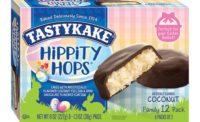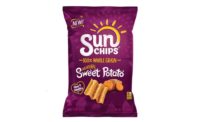As much as the tortilla category stays the same, it also has been striving to include more clean-label, non-GMO, and organic options.
The standard white flour or corn tortilla that you see on grocery shelves will continue to persist, but consumers may see vegetable options like sweet potato tortillas alongside them, too.
Overview | Bread | Tortillas | Sweet Goods | Snack Cakes | Pizza | Desserts | Cookies | Buns & Rolls | Bars | Breakfast Products
Market data
According to data from IRI, Chicago, over the past 52 weeks ending March 25, 2018, hard/soft tortillas and taco kits saw positive sales results. The segment is up by 3.05 percent to $2.46 billion in sales. Gruma Corp. controls roughly half of the market share for tortillas in the U.S. and takes the top two spots, including segment leader Mission Foods.
Mission Foods saw dollar sales up 6.09 percent to $786.1 million for the year. Gruma Corp. follows, with $397.4 million in sales and a slight increase of 0.48 percent.
Eight of the top 10 brands in the segment saw positive growth for the year. Gruma’s primary brand, Guerrero, was up 0.97 for the year to $373.8 million. Mission Foods saw success with its Carb Balance line, which grew 10.62 percent to $93.8 million. Private label sits in the No. 3 spot for the segment and was up 3.32 percent to $203.4 million.
The Ole Mexican Foods brand La Banderita grew 1.84 percent to $182.0 million, while its health-oriented Xtreme Wellness line grew 35.70 percent to $37.2 million. Old El Paso, a General Mills brand, grew 4.53 percent to $177.3 million. Its Old El Paso Stand ’N Stuff crispy shells line grew 2.31 percent to $90.5 million.
Another notable performance for the year was El Milagro’s flagship brand, up 25.58 percent to $52.5 million.
Refrigerated tortillas took a downturn for the year, per IRI, dropping 3.83 percent to $95.2 million. But the segment still shows promise, with a handful of companies showing growth. Segment leader Circle Foods grew 9.79 percent to $30.4 million, while the No. 3 company in the segment, La Abuela Mexican Foods, grew 9.69 percent to $8.3 million. Cacique USA brings product diversity to the segment with its Sopes de la Casa line, which grew 26.76 percent to $1.3 million.
Looking back
“Healthy” was the buzzword in the tortilla segment this year. “The growing demand for healthy options continues to be a driving force in the tortilla industry,” says Kevin Regan, tortilla product sales manager, Taconic, Petersburgh, NY. “Although traditional corn and flour tortillas comprise the bulk of tortilla manufacturing, the market has evolved to include niche offerings that provide healthy, flavorful alternatives.”
Regan explains that because the American population has “diverse dietary restrictions,” tortilla manufacturers have expanded their product lines to meet the need for organic, low carb, non-GMO, gluten-free, wheat-free, whole grain and even vegetable-infused alternatives.
Angelic Bakehouse released three varieties of Sprouted 7 Whole Grains veggie wraps, including Beet, Kale & Spinach and Sweet Potato. The wraps are Non-GMO Project Verified, and the brand also released a reduced-sodium version.
“The entire tortilla category of corn and flour tortillas continues its trajectory, gaining increases in the base of devotees, as well as picking up new fans from a variety of ethnic groups from around the world—and also from those with a better understanding of their own diet restrictions,” says Glenn Shelton, vice president, Lawrence Equipment, South El Monte, CA.
Shelton says some of the new ingredients creative tortilla producers are focusing on include almond flour, coconut flour, cassava flour and chia. “There seems to be no end to the demand for non-traditional doughs that appeal to consumers searching the tortillas aisle in the hope of finding a good tasting non-grain flatbread.”
The ever-widening array of dough types has put pressure on Lawrence to develop features that broaden the window of success for producers with Lawrence Equipment lines, Shelton says. “New divider components, including pistons, rounding drum options and small ball control rollers, as well as a press camera with auto sizing, have been completed with very good market reception.”
Although clean label generates the most interest, vegan, non-GMO and organic options are gathering more attention, says Randy Schmelzel, CEO, Allied Blending, Keokuk, IA. “There has been more emphasis on nutritionals due to the new food labeling regulations,” he says, “as well as improved quality—appearance, taste, texture—for mainstream tortilla markets with improved shelf stability.”
People are interested in getting creative with tortillas, which drives increased purchase. “We continue to see that the alternative/better-for-you trend is driving new consumers to try tortillas as alternative versions of flatbreads every day,” says Mauro Gomez, vice president of sales and marketing, La Reina/Anita’s Snack Foods, Los Angeles. “Tortillas are flexible, no pun intended. People are using them in so many ways. The category itself is still driven heavily by the growing number of Hispanics and people’s continued interest in Mexican food.”
Gomez notes growing interest in alternative flours like cassava and coconut—and also hemp—along with a growing demand for organic tortillas. “People want clean and simple ingredients, as well as labels they can read and understand.”
Grain Craft, Chattanooga, TN, has seen continued steady growth of its flour sales for tortillas, says Kirk Stehr, senior vice president of sales. “The tortilla industry is in a healthy state. We have found that our tortilla manufacturer customers are continually trying new techniques, such as enhancing the softness and texture of tortillas, and are even emphasizing the ‘crafted’ aspect with artisan-style tortillas.
“As these new tortilla options continue to flood the market, the consumer trends are showing that tortillas are becoming more and more of a staple in daily meal planning in U.S. homes,” continues Stehr. “The low cost of tortillas, ease of preparation and range of options for consumers are key drivers for this strong industry.”
Looking forward
The idea of “freshness” holds strong appeal, and Shelton notes a growing demand for unbaked roti and tortillas. These products continue to gain popularity, he notes, but require special packaging and must be kept frozen or refrigerated. “Consumers like it because they are able to create a fresh, just-made eating experience, preferring their own light crisping of their tortilla just before being eaten,” he says.
The tortilla industry will continue to strive for cleaner labels, upping its already vast set of offerings. “We continue to simplify and use more natural ingredients throughout our product offerings,” says Schmelzel. “The goal is to develop market-demanded products with improved functionality and taste that meet and exceed consumer preferences.” He admits that understanding the impact of alternative formulations on processability, finished product quality, shelf stability and nutrition continues to be a challenge.
There’s a growing demand of millennials wanting and looking for new and innovative products, too, and because of that, La Reina and Anita’s Snack Foods continue to focus their efforts on innovating around the “visual and textural use of exotic ingredients and flavors,” says Gomez.
Regan suggests whole grains like teff and millet flour, in addition to unbleached wheat flour, for ingredients that can boost nutrients in tortillas. “The use of preservatives, artificial colors and hydrogenated oils are also on the decline.”
Size matters, too: consumers will see a variety of tortilla sizes on the shelf—from the smaller street taco sizes to the larger fajita, burrito and chimichanga sizes, notes Regan. These products also often vary in their thickness. “Flavored varieties and 50/50 corn/flour tortillas offer additional options for consumers. These types of ingredients are often more difficult to process, since the dough may be stickier or abrasive, making nonstick tortilla press belts a more-critical factor in the manufacturing process.”
But as long as there is consumer demand, manufacturers will continue innovating to meet it. “We need to push ourselves to the limit when it comes to meeting the growing demand for new and innovative items,” says Gomez. “This means re-investing to develop new and unique processes."
Overview | Bread | Tortillas | Sweet Goods | Snack Cakes | Pizza | Desserts | Cookies | Buns & Rolls | Bars | Breakfast Products









